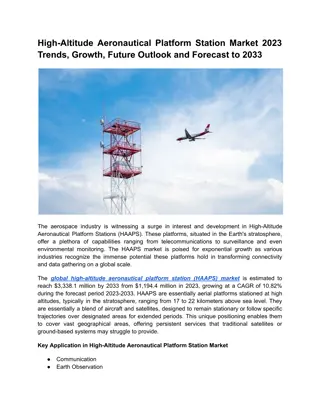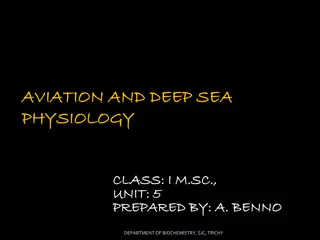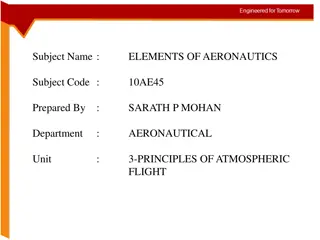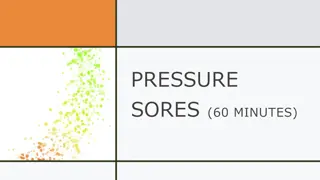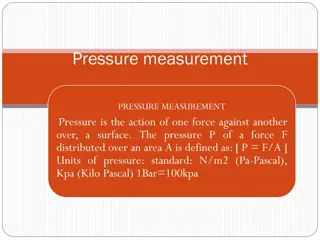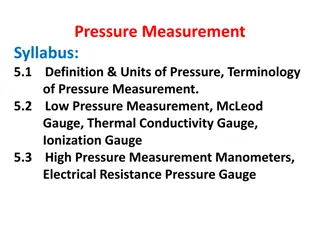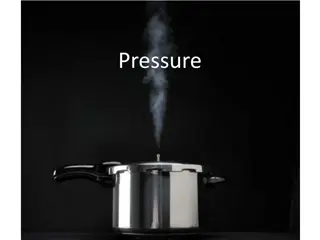Understanding Barometric Pressure and Its Impact on Altitude
Barometric pressure, also known as atmospheric pressure, is the force exerted by the weight of air on a specific area and varies with altitude. This pressure is crucial in various industries, such as cement production at high altitudes. Learn about how to calculate barometric pressure, its relation to altitude, the difference between relative and absolute pressure, and more in this informative guide.
Download Presentation

Please find below an Image/Link to download the presentation.
The content on the website is provided AS IS for your information and personal use only. It may not be sold, licensed, or shared on other websites without obtaining consent from the author. Download presentation by click this link. If you encounter any issues during the download, it is possible that the publisher has removed the file from their server.
E N D
Presentation Transcript
PRESSURE JD JULIO 2016
BAROMETRIC PRESSURE: A. - Barometric pressure It is the weight of the air pressing on specific area and normally called atmosphere. It often is expressed in different units such as bar or milibar, kg/cm2, psi etc. In any case it is a force on a unit of area. This force also can be expressed by the height of some liquid such as mercury or water which then is mm or inches Hg (mercury), mm or inches WC (water column). The height multiplied by the specific gravity of the liquid gives the height in water column. If that is expressed in mm the value is equal to pressure in kg/m2. It is clear then, that the atmospheric pressure changes with altitude. The higher the location, the lower the weight of air that has to be supported by the surface, which means that the pressure is lower than it is on sea level.
BAROMETRIC PRESSURE: This relation is not linear and the pressure can be calculated by the following equation: ??= ???? 0.0001255 ?? Psl: 760 mmHg hsl: m
PRESSURE VS ALTITUDE: Barometric pressure depending of altitude (mm WC) 12000 10000 8000 6000 4000 2000 0 0 1000 2000 3000 4000 5000 6000 7000 8000 9000
Some cement plants at high altitude: Cementos Andino (Peru) 4400 m Sociedad Boliviana de Cemento (Bolivia) 4000 m Cementos Paz del Rio (Colombia) 2560 m Cementos Samper (Colombia) 3000 m Exercise: calculate the barometric pressure at these plants The average pressure at sea level is the Normal pressure , which is mostly expressed in mercury column (mm or inches).
Exercise: calculate the height of the water column Void Water column = mm 1 Atm.
RELATIVE PRESSURE: Relative pressure That is the pressure inside a vessel, duct etc. The value shows the difference between the outside pressure and the pressure inside the vessel or duct. 1 Atm dh = 100 mm
ABSOLUTE PRESSURE: C. - Absolute pressure The absolute pressure is the sum of the barometric pressure plus the relative pressure: Pabs = Pbarometric + Prelative 100 m Air at 1000 deg C dh = 0
ABSOLUTE PRESSURE: EXAMPLE. Example: Stack closed at the top. Gas temperature: 1000 deg C Stack height:100 m Gas: Air, normal ambient conditions. Exercise: Calculate the absolute and relative pressure at each measuring point
ABSOLUTE PRESSURE: EXAMPLE. Example: Preheater ID fan, Gas temp. 350 deg C, distance between A and B , 70 m. specific gravity of the gas 1.4 kg/Nm3. A dh = 500 mm WC Calculate the relative and absolute pressure at A and B B dh = mm WC
STATIC PRESSURE: D. - Static pressure: All gases expand evenly in all directions. In a vessel where no movement is present, the pressure measured in any of its walls is the same. Because there is no movement, only static pressure is present.
DYNAMIC PRESSURE: E. - Velocity pressure or dynamic pressure: Velocity pressure is produced by the gas movement and it is the kinetic energy produced by the moving gas stream. In our applications in the cement plant we have mostly moving gases. The velocity pressure can be calculated as follows Vp = v 2g 2 where the following symbols are used: Vp = Velocity pressure (mm WC) = specific gravity (kg/m3) g = gravity The velocity pressure increases with the square of the velocity and proportional to the specific gravity.
TOTAL PRESSURE: F. - In a system with moving gases the total pressure is the sum of static pressure + velocity pressure Total pressure Pt = SP + Vp In a system without pressure losses the total pressure is constant.
EXAMPLES AND EXCERCISES: G. - Examples and exercises Example: Assumption no pressure losses Ductwork at the fan outlet, static pressure 100 mm WC Gas = Air under normal conditions. Area 1 = 1 m2, area 2 = 0.5 m2 Gas volume: 1200 m3/h
EXAMPLES AND EXCERCISES: Example: Draw the lines for static pressure and the lines for velocity pressure
EXAMPLES AND EXCERCISES: Example: Assumption no pressure losses Ductwork at the fan outlet, static pressure 150 mm WC Gas = Air under normal conditions. Area 1 = 0.5 m2, area 2 = 1 m2 Gas volume: 1200 m3/h
EXAMPLES AND EXCERCISES: Example: Draw the lines for static pressure and the lines for velocity pressure
EXAMPLES AND EXCERCISES: Example: Assumption a. - no pressure losses b. - with pressure loss Ductwork at the fan inlet Gas = Air under normal conditions. Area 1 = 1 m2, area 2 = 0.5 m2 Gas volume: 1200 m3/h
EXAMPLES AND EXCERCISES: Example: Draw the lines for static pressure and the lines for velocity pressure
EXAMPLES AND EXCERCISES: Example: Assumption a. - no pressure losses b. with pressure loss Ductwork at the fan inlet Gas = Air under normal conditions. Area 1 = 0.5 m2, area 2 = 1 m2 Gas volume: 1200 m3/h
EXAMPLES AND EXCERCISES: Example: Draw the lines for static pressure and the lines for velocity pressure
EXAMPLES AND EXCERCISES: Duct on the fan outlet side, static pressure 200 mm WC Gas: Air under normal conditions No pressure losses Fan static pressure 100 mm WC Gas velocity: 10 m/s
EXAMPLES AND EXCERCISES: Draw the different height of water columne according to the indicated measurements.
EXAMPLES AND EXCERCISES: Duct on the fan inlet side Gas: Air under normal conditions No pressure losses Gas velocity: 10 m/s
EXAMPLES AND EXCERCISES: Draw the different measurements in mm WC
EXAMPLES AND EXCERCISES: Ductwork connected to fan inlet Area 1 = 1 m2, Area 2 = 0.5 m2, Area 3 = 2 m2 Gas: Air under normal conditions Gas volume: 36,000 m3/h No pressure loss
EXAMPLES AND EXCERCISES: Draw the different measurements in mm WC.
EXAMPLES AND EXCERCISES: Ductwork connected to fan outlet, static pressure 300 mm Area 1 = 1 m2, Area 2 = 0.5 m2, Area 3 = 2 m2 Gas: Air under normal conditions Gas volume: 36,000 m3/h a. - No pressure loss b. - With pressure loss
EXAMPLES AND EXCERCISES: Draw the lines for velocity pressure and static pressure
EXAMPLES AND EXCERCISES: Ductwork connected to fan inlet Area 1 = 1 m2, Area 2 = 0.5 m2, Area 3 = 2 m2 Gas: Air under normal conditions Gas volume: 36,000 m3/h a. - No pressure loss b. - With pressure loss
EXAMPLES AND EXCERCISES: Draw the graph for velocity pressure and static pressure
EXAMPLES AND EXCERCISES: On the suction side of the fan -100 mm WC is measured and on the discharge side + 50 mm WC. Indicate the velocity pressure and the total pressure if the volume flow is 24.000 m3/h, The area at the inlet is 1.5 m2 The area at the outlet where the measurement is taken is 1.5 m2 No pressure losses are considered.
EXAMPLES AND EXCERCISES: On the suction side of the fan -100 mm WC is measured and on the discharge side + 50 mm WC. Indicate the velocity pressure and the total pressure if the volume flow is 24.000 m3/h. The area at the inlet is 1.0 m2 The area at the outlet where the measurement is taken is 1.5 m2 No pressure losses are considered.
EXAMPLES AND EXCERCISES: On the suction side of the fan -50 mm WC is measured and on the discharge side + 50 mm WC. Volume flow is 30.000 m3/h, Fan inlet and outlet area is 1.0 m2 The enlarged area is 2.0 m2 Draw the curve for static pressure and velocity pressure a. - No pressure losses are considered. b. - With pressure loss
EXAMPLES AND EXCERCISES: On the suction side of the fan -100 mm WC is measured and on the discharge side + 50 mm WC. Volume flow is 24.000 m3/h, Fan inlet area = Fan outlet area = Enlarge area = a. - No pressure losses are considered. b. - With pressure loss 1.0 m2 1.0 m2 2.0 m2
EXAMPLES AND EXCERCISES: Inlet area 1 m3 F1 = 0.5 m2 F2 = 1.5 m2 F3 = 0.75 m2 F4 = 0.5 m2 F5 = 1.0 m2 F6 = 2.00 m2 Gas: Air under normal conditions Gas volume: 72,000 m3/h Fan pressure: 250 mm a. - No pressure losses are considered b. - With pressure loss
EXAMPLES AND EXCERCISES: F6 F4 F5 F1 F3 F2 Draw the curves for static pressure and velocity pressure



